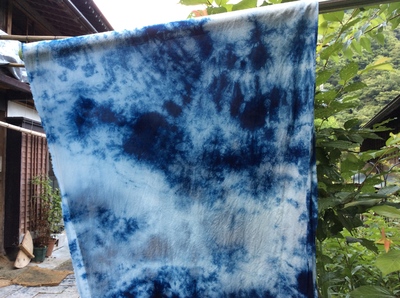After residing in Tokyo for five weeks, the calmness of Fujino was a welcome relief. What a joy to wake up every morning to this spectacular view!
One of the first pieces I made was a linen scarf using a binding cord. Here is what the piece looked like before it was dyed:
And this is what it looked like after it was opened and left to dry in the crisp mountain breeze:
In general, I am not very skilled at
working with my hands, so items that required stitching tested my
patience. Not to say that it wasn't worth the effort, but sitting down
on the floor for hours upon hours sticking a piece of fabric was tiring!
So, every once in a while I had to get up and take a break. What a
better way to break of the monotony of stitching than to dye something
and see the results more or less immediately. Seriously, I can
understand why Bryan doesn't teach this shibori technique I am about to
discuss before any of the traditional methods. Basically, a piece of
cloth is scrunched into a ball and wrapped using rope. It is dunked
three times in the vat, and then the rope is removed, the fabric is
turned inside out, and the process is repeated. Here is a photo to
illustrate what it looks like before dying:
And this is what it looks like after dying:

I made about four of these scarfs using
silk fabric during my time and vowed to keep one for myself! Bryan also
took time to introduce us to his silk worms, and showed us how he
extracts silk from the worms using a loom:
During my time in Fujino, there were a
number of other people learning inidigo and shibori from Bryan,
including an aspiring Australian designer who made over 100+
scarves! She was using much simpler techniques (i.e. no stitching), but I
was impressed at how beautiful here pieces came out. She left for
Sydney while I was there, but evidently she sold 18 of them in one day
at a local Sydney market the weekend after her return!
One of the last pieces I made was a
bandana. This was a small piece but the stitching was quite intricate
and elaborate. I had to leave before this piece was completely finished
but I looking forward to seeing how it turns out! I'll pick it up the
next time I go to Japan or ask Bryan to mail it me.
For many years I have been mesmerized by
the vitality and richness of indigo-dyed fabric. It was just a short
time that I was in Fujino, but more than anything, I felt that I gained a
deep appreciation for the sheer artistry and craftsmanship that goes
into creating even the simplest of pieces. It is difficult to know at
the this stage what I will do with this new-found hobby of mine. I'm not
sure if I can create a studio in my home to continue to create indigo
pieces, but at the very least I know I have a place in Japan where I can
return to to learn more about this fascinating tradition. It would be
difficult to find a period in my life when I have been happier during
the past year or so than the time I spent in Fujino in late June 2014!
No comments:
Post a Comment
Note: Only a member of this blog may post a comment.